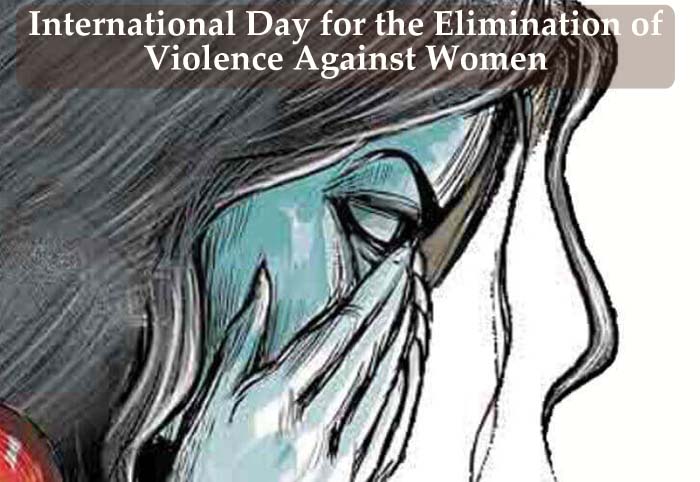International Day for the Elimination of Violence Against Women

Women’s rights activists observe 25th November as International Day for the Elimination of Violence Against Women since 1981. This date was selected to honor the Mirabal sisters, three political activists from the Dominican Republic who were brutally murdered in 1960 by order of the country’s ruler, Rafael Trujillo (1930-1961).
The day is to call for the prevention and elimination of violence against women and girls which has become a global issue that poses a threat to women around the world. The violence against women includes rape, domestic violence, and other forms of violence and the day aims to highlight the scale and nature of the issue which usually remains hidden.
The theme for the year 2025 is “UNiTE to End Digital Violence against All Women and Girls”.
In recent years we have heard voices of survivors through campaigns such as #MeToo, #TimesUp, #Niunamenos, #NotOneMore, #BalanceTonPorc, and have the spotlight on issues related to women violence which otherwise remain silenced and unheard of.
On the occasion of International Day for the Elimination of Violence Against Women, we are sharing rights provided to Indian women by the Government of India of which many women are unaware.
Laws in India related to women
- The Dowry Prohibition Act, 1961 (28 of 1961) (Amended in 1986)
- The Indecent Representation of Women (Prohibition) Act, 1986
- The Commission of Sati (Prevention) Act, 1987 (3 of 1988)
- Protection of Women from Domestic Violence Act, 2005
- The Immoral Traffic (Prevention) Act, 1956
- The Sexual Harassment of Women at Workplace (PREVENTION, PROHIBITION, and REDRESSAL) Act, 2013
- The Criminal Law (Amendment) Act, 2013
Violence against women
Violence against women occurs throughout the life cycle from pre-birth, infancy, childhood, adolescence, adulthood to senescence. According to the National Crime Record Bureau, India, there is one dowry death in the country every 78 h, one act of sexual harassment every 59 min, one rape every 34 min, one act of torture every 12 min and almost one in every three married women experienced domestic violence.
Suggested Read: National Women’s Health & Fitness Day
Domestic violence
A home is a place where an individual seeks love, safety, security, and shelter but for women, a home is a place that breeds the most drastic forms of violence. Violence is usually perpetrated by males who are, or who have been in positions of trust and intimacy and power e.g. husbands, fathers, fathers-in-law, stepfathers, brothers, uncles, sons, or other relatives.
Protection of Women from Domestic Violence Act, 2005 defines domestic violence as any act, omission, or commission or conduct of the respondent, which includes the threat or actual abuse. The men indulged in violence to establish their power over the weaker sex. Subtle and insidious forms of violence include repeated humiliation, insults, forced isolation, limitations on social mobility, the constant threat of violence and injury, and denial of economic resources.
Suggested Read: The Changing Status Of Indian Women
Sexual Harassment at the workplace
There have been a daily lot of cases regarding sexual harassment at the workplace and this Act is to protect women from sexual harassment at their place of work
Dowry related violence
The age-old practice of dowry has persisted in India and driven many women to suicide. Dowry-related violence is on the rise in India. More than 5000 women are killed annually by their husbands and in-laws, who burn them in “accidental” kitchen fires if their ongoing demands for dowry before and after marriage are not met. On an average of five women, a day is burned, and many more cases go unreported.
Suggested Read: National Women Day of India
Other Causes of Violence against women
Psychiatric morbidity: Alcohol consumption, bipolar disorder, paranoid schizophrenia, delusional, and antisocial personality disorder make the man more vulnerable to commit sexual crimes.
Sociodemographic factors: Patriarchy has been cited as the main cause of violence against women. Where women have a higher economic status than their husbands and are seen as having sufficient power to change traditional gender roles, the risk for violence is high.
Family factors: Exposure to harsh physical discipline during childhood and witnessing the father beating the mother during childhood is a predictor of victimization and perpetration of violence against his wife in adulthood. In addition, the age-old custom of dowry and gifts for husbands and in-laws has been found to be strongly related to violence against women in India.
Suggested Read: International Women Day
Married women with mental illness: Women with severe mental illness are ostracized on three accounts, female status, psychosis, and separated/divorced status, which together constitute the triple tragedy. These women are helpless and suffer from a multitude of stresses that are unique to Indian culture.
Traditional and cultural practices perpetuating violence against women- Female genital mutilation
- Acid attacks
- Killing in the name of family honor
- Early marriages
Stereotypes of gender roles have continued especially in India, where women’s primary role is limited to marriage and motherhood. The marriage can’t be dissolved and the Daughter-in-law (Bahu) means she should adjust and be tolerant and respectful towards family, while the husband is given a divine status.
She should bring money and gifts from her parents to various festivals. She has nothing of her own. Without their husband life has no meaning for her. Although the practice of Sati has declined, enforced widowhood is still prevalent.
Suggested Read: Women Equality Day
ModernizationIn today’s modern world Mobiles, Ipads, television, computers, the internet have become the order of the day. Women are moving out of the houses more freely and there is free mixing of the two genders. “Fashion, Drink, Dine and Make Merry” or “You live only once” culture is promoted among youth which has been the reason for Late marriages and Life stress among youth.
Last, but not least, If we are sincere we will get the results. Let us all say “No” to violence against women.
References: ncbi.nlm.nih.gov, ncw.nic.in